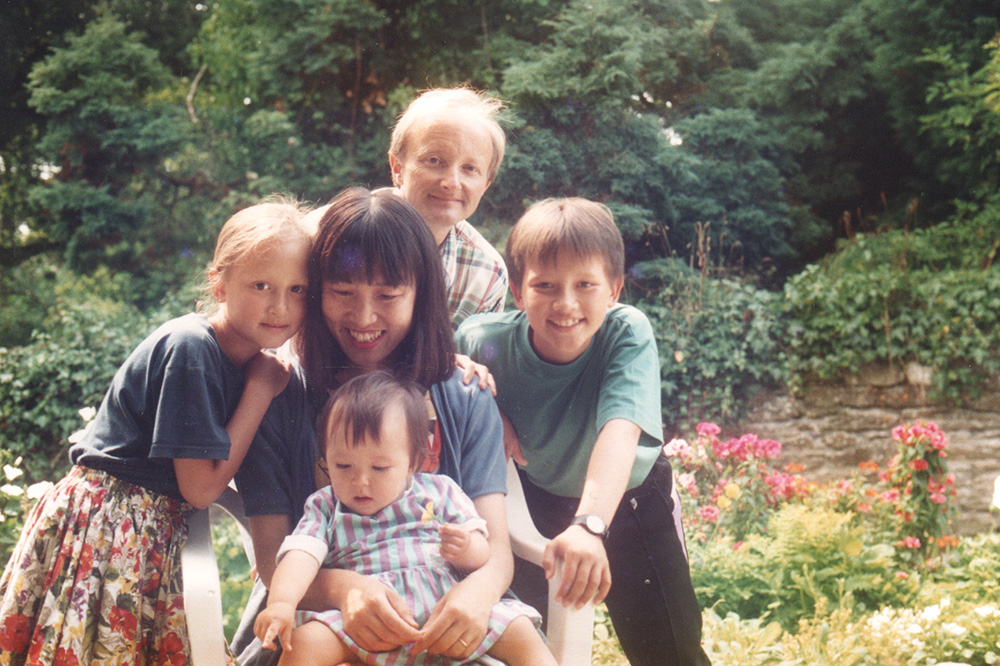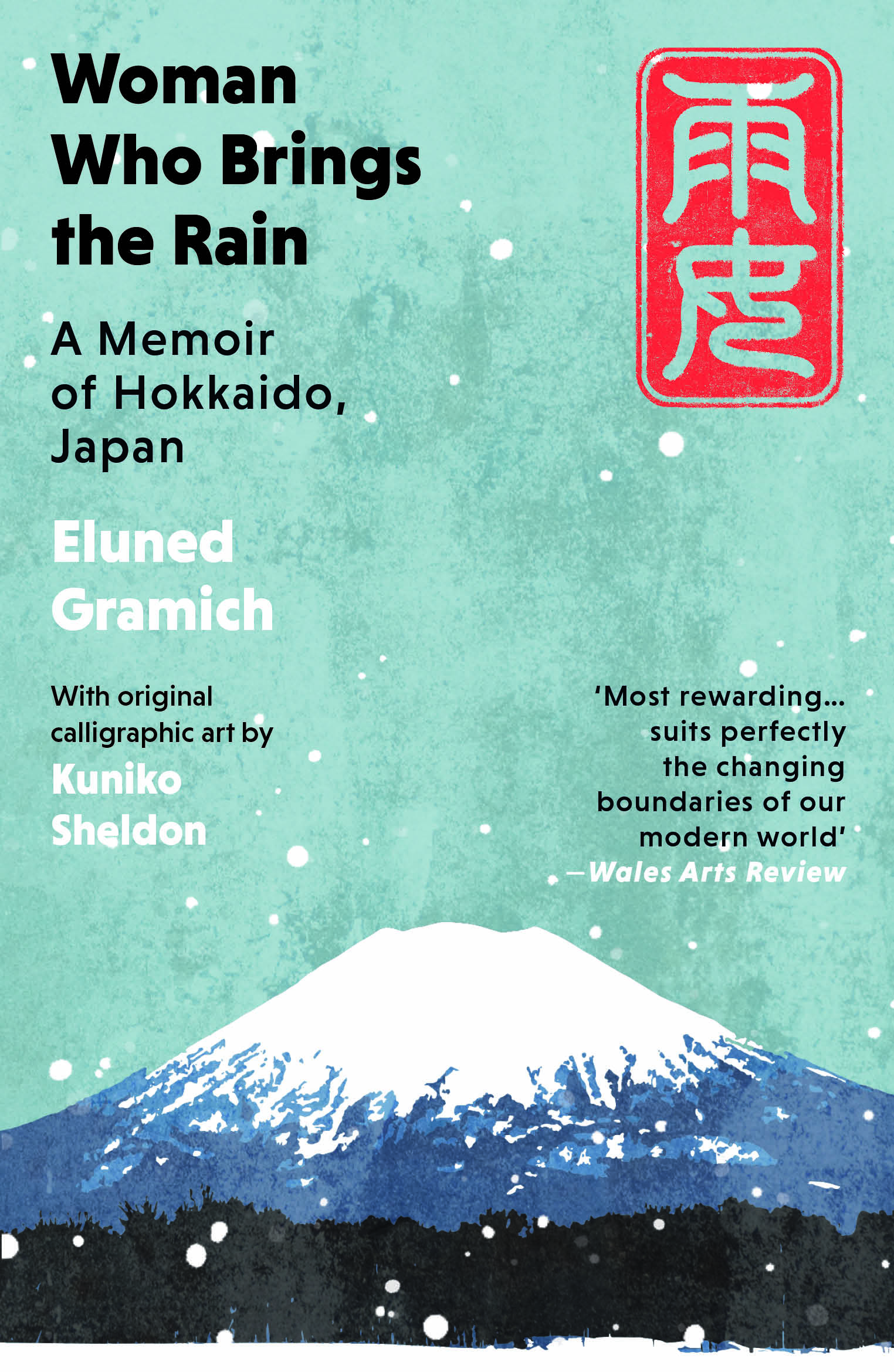Kuniko Sheldon – from Japan to west Wales

“As a girl in Japan, I studied formal calligraphy, but later left the black-and-white world. When I moved to Wales, I felt it was a ‘watercolour country’, and I was swept away by colours and the effects of blending colours. More recently though I have been breaking away from traditional Japanese forms and discovering how to breathe power, energy and freedom into my calligraphic works.’’ Kuniko Sheldon (1956-2020)
Kuniko Tanigawa, artist and traveller, was born in Osaka, Japan in 1956, the eldest of three children. She enjoyed a happy post-war childhood in a home with her siblings, parents and grandmother. Since the end of the war, people in the region struggled to rebuild and the family largely subsisted on a diet of rice and vegetables from their farm, a chicken if there were guests or a special occasion.
The city gradually expanded, encroaching on the land while unregulated factories began to appear, contaminating the soil, and farmland was paved over and replaced with warehouses, businesses and housing for a growing population. Kuniko saw this progress as she trained in design and art and teaching. Her passion at the time was for calligraphy, the art of writing in Japan using the symbols of kanji.
Nature
It was at this time she fostered a deep appreciation for nature, and her favourite landscapes were views of the mountains of northern Japan. She carried this deep affinity with nature into her calligraphy. She would also qualify as a teacher.
One of her first jobs was for the electronics giant Panasonic, who had their head office in Osaka. Eager to compete in the world market and to be seen as international, the company began to offer its employees English classes. Kuniko’s teacher was a young man of the same age, Eric Sheldon. A linguist from the United Kingdom studying and teaching in Japan. Within a few years they were married and began to build a life together in Japan.
Eric Sheldon had studied plant pathology in the UK and dreamt of owning a farm. His work in Japan was initially the chance to earn and save money. He had not expected to stay so long. By 1992 the couple already had two young children, Kenji and Aya, but they took the decision to move to the Teifi Valley in west Wales.
The move was not one that Kuniko took to very easily at first. She had always enjoyed her familiar surroundings in Japan, a farming culture but close to the city. It was going to be something of a challenge to relocate to a chilly and relatively isolated stone house on the other side of the world. Their children were then seven and nine and Kuniko was naturally concerned about what such a big change would bring for them. Nevertheless, they decided to embrace the move and bought a small-holding in Llandygwydd, a few miles inland from Cardigan.

Developing Skills
They arrived in August, but already it felt cold. It was 32˚C in Osaka, 16˚C in Cardigan. Kuniko felt that she was too far from everything, too isolated, and couldn’t really see what kind of life she might lead; but her interest in patchwork brought her into contact with other textile artists, and soon she found that she wanted to start painting again. She was keen to develop her watercolour skills, particularly the wet-in-wet technique in which colours and water blend directly on the paper. She took classes, and it was here that she befriended other painters. Her network expanded, and she quickly made friends. Life in Wales also saw the arrival of their third child, Sally.
Kuniko was taken by the beauty of the rounded green hills of Wales, the misty air and soft light of the region. ‘I felt it was a watercolour country, and I was swept away by colours and the effects of blending.’
She went on to produce a body of work in watercolour, frequently exhibiting, and becoming a member of the Newport Art Group and Cardigan Art Society. On a weekly basis, she also painted with a group in the local church hall and at a class in Rhosygilwen. These groups all held exhibitions, and the highlight of her year was the annual exhibition at Waunifor, near Llanfihangel, where she proudly exhibited alongside other artists. Several galleries in Cardigan also held her work.
Exhibitions
In 2019, Kuniko exhibited back home in Osaka, and for two weeks, alongside the general public, family and friends, the local farming community who she’d known since childhood, old school friends, and the children’s former school-teachers gathered to admire her work. It was a precious time, and Kuniko enjoyed the chance to re-connect with people from her past. She was sixty-three.
Kuniko returned to calligraphy in Wales at this time, with a matured hand and the influence of the undulating hills. It has been said that the skill of the artist/calligrapher goes far beyond rendering the seemingly simple ink strokes. They must bring mind and soul to the work and create with heart. In time, and quite intuitively, a signature style arises. She was working on extending her calligraphy when she died of a brain tumour, in 2020.
This dance between the cultures of Wales and Japan is something to be celebrated, and when Eric Sheldon was approached about publishing some of his wife’s calligraphy to illustrate Eluned Gramich’s memoir of living in Hokkaidō in Japan as a student of the Japanese language, Woman Who Brings the Rain, it seemed a perfect pairing. Gramich’s memoir won the New Welsh Writing Award, and is now published in a new edition with Kunika Sheldon’s prints by Parthian.

Kuniko’s artistic journey may have begun with the disciplined elegance of Japanese calligraphy, but it was in the misty ‘watercolour’ hills of Wales that her brush found new freedom, blending traditions of East and West into something unique.
The book is a story of youthful adventure, close observation, and personal transformation; and at its heart it shares a beautiful appreciation of the broad and slender brushstrokes of the calligrapher. Kuniko’s work balanced between Eluned’s journey to the northern mountains on the island of Hokkaidō.
‘…you should be focussed and calm before you take your calligraphy brush in hand. You should be filled with good intentions.’
‘Woman Who Brings the Rain,’ Eluned Gramich
This Exhibition launch of Kuniko Sheldon’s kanji prints illustrates a new edition of the critically-acclaimed memoir of living in Japan and learning to speak Japanese, Woman Who Brings the Rain by Eluned Gramich.
The exhibition is free to enter, opens just after midday on the 29th of September in Y Cartws/The Coach House, Shingrig, St Dogmaels, Pembrokeshire, and will run throughout October.
Support our Nation today
For the price of a cup of coffee a month you can help us create an independent, not-for-profit, national news service for the people of Wales, by the people of Wales.





What a great story about Japanese artist Kuniko Tanigawa and her family. I hope she enjoys her adopted homeland and the Welsh countryside gives her inspiration.